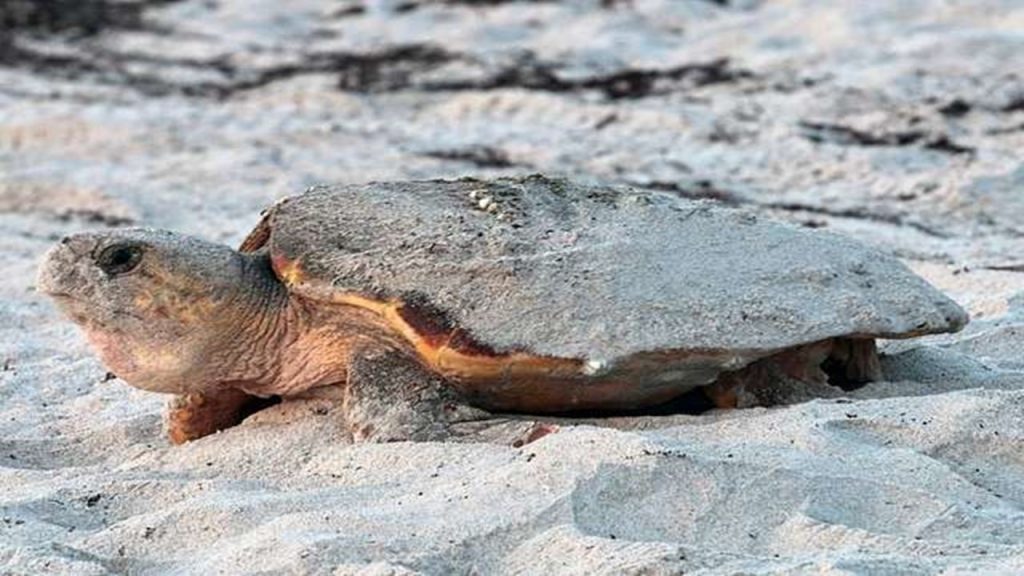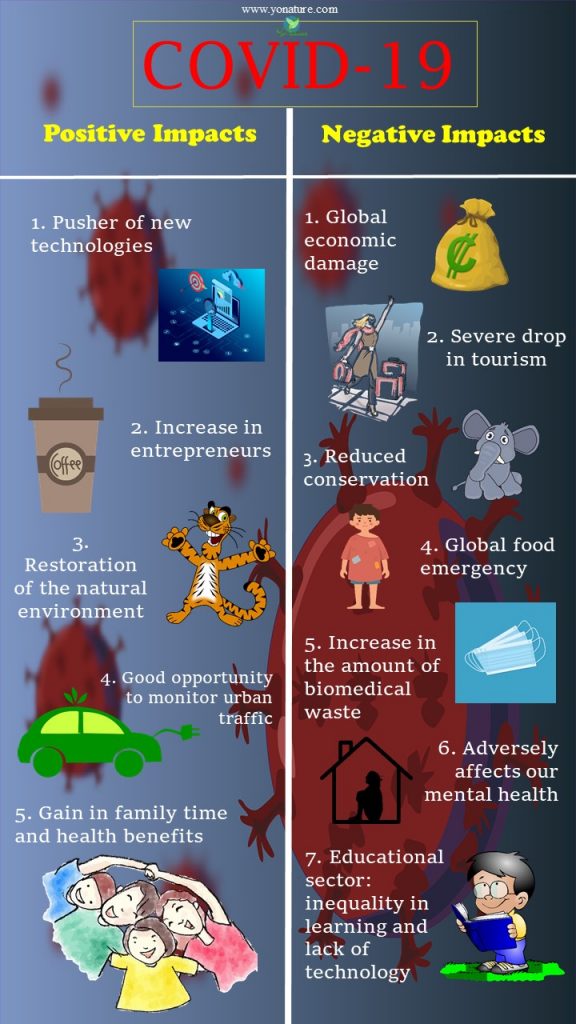Positive and Negative Impacts of COVID-19

The outbreak of the coronavirus, or COVID-19, shook the whole world. Since early 2020, the pandemic has led to dramatic changes in every aspect of human lives. As the virus traveled around the globe infecting millions of people, a number of stringent measures were put in place. Lockdowns, sanitary measures, travel restrictions restructured every part of our normal routine. As a result, the COVID-19 pandemic led to both positive and negative impacts.
What is COVID-19?
As a matter of fact, it’s not the first time that a viral pandemic has occurred. Today’s situation is very much like the Spanish Flu, an influenza pandemic in 1918. The H1N1 virus was the culprit leading to about 50-100 million deaths globally.
So, COVID-19 stands for CO – Corona, VI – Virus, and D – Disease. 19 refers to the year we discovered the strain in 2019. Specifically, COVID-19 is a strain of the SARS-CoV-2 or Severe Acute Respiratory Syndrome coronavirus. As the name suggests, COVID-19 is a disease that predominantly affects the respiratory system. Thus, symptoms include coughing, breathing problems, tiredness, etc.
Past outbreaks of coronaviruses during the period 2000 to 2020
As it is, coronaviruses come from a large family of viruses that can infect humans, mammals, and birds. They can then cause mild to quite severe respiratory infections in their hosts. Right now, we record three outbreaks of coronaviruses during the period 2000 to 2020.
1. 2002-2004 SARS outbreak
The first one is the SARS-CoV-1. It caused the 2002-2004 SARS outbreak in Asia with secondary cases around the world.
2. Middle East Respiratory Syndrome, camel flu
The second outbreak is the MERS-CoV or Middle East Respiratory Syndrome. We also call it ‘camel flu’. Identified in 2012 in Saudi Arabia, it is also an infectious disease that causes respiratory problems.
3. COVID-19 outbreak
And the last one is the SARS-CoV-2 outbreak that leads to the current COVID-19 pandemic.
Positive impacts of COVID-19
1. Pusher of new technologies
Without a doubt, one of the most evident impacts of COVID-19 is that it is the pusher of new technologies. Though most of these technologies already existed, the current pandemic took digital transformation to a whole new level.
As students, parents, and businessmen had to stay at home, a new digital transformation occurred to keep up. Thus, there was an acceleration in remote working, online studying, and business networking.
Increased demand for Zoom and Extended Reality
For example, the demand for Zoom significantly increased for people to work remotely. At the same time, Zoom upgraded its Cloud storage to keep up with the demand. Likewise, Extended Reality enhanced the customer service of many people when shops were closed.
Deploying the faster and more reliable 5G
Additionally, many companies took the opportunity to deploy the faster and more reliable 5th generation of the internet, 5G. Globally, the number of devices connected to the internet and data streaming is increasing significantly. Hence, with 5G, more organizations and individuals can adopt a wider range of technologies.
2. Increase in entrepreneurs
Another important impact of the COVID-19 pandemic is a clear increase in the number of entrepreneurs. Interestingly, the pandemic pushed many individuals to experiment and launch small businesses. For example, with lockdowns, many coffee shops shut down and many people lost their jobs. As such, entrepreneurs took the opportunity to start their mobile coffee delivery service in vans.
As the ordeal changed the way consumers act and react, small entrepreneurs jumped in to bridge the gap. They reacted quickly, responding to customers’ demands and changes in habits. Thus, the number of local pastry makers, online shops, and mobile delivery services quickly escalated.
3. Restoration of the natural environment
Perhaps one of the most impressive benefits of the COVID pandemic is on the natural environment.
a. Considerable drop in pollution
In many areas around the world, air, water, and noise pollution considerably decreased. As an example, the emissions of harmful gases decreased by 25% in China in 2020. As a result, the air quality improved by 11.4%.
Likewise, polluted waterways are looking cleaner. For instance, the Ganges in India is one of the most polluted rivers in the world. Data reveals that since the pandemic occurred, its water quality improved by 40-50%!

b. Significant drop in carbon dioxide levels
Likewise, the levels of carbon dioxide in our atmosphere dropped because of COVID lockdowns around the world. Experts contend that it is the biggest decline in anthropogenic carbon emissions since World War II. In China alone, carbon dioxide emissions fell by 200 million metric tons thanks to confinement measures. Scientists estimate that at least 77,000 people are still alive right now because of this.
c. Wildlife and plants began to thrive
What’s more, as we retreated indoors, wildlife and plants began to thrive. For example, the number of animals that die in vehicle accidents such as cars and boats decreased. Also, with more space to roam and settle, animal populations rose. In Florida, for instance, the nesting success of loggerhead turtles rose by 39% as beaches closed.

4. Good opportunity to monitor urban traffic
Today, one of the most pressing issues that we are facing is congestion. But with the COVID-19 lockdown, worldwide mobility plummeted. In many countries, transport authorities report up to a 95% decreased use of public transport.
Consequently, congestion levels also considerably dropped globally. The road traffic in Barcelona, Spain, declined by 80% since lockdown. Likewise, truck transportation dropped by 10% in India while global air travel dropped by 96%!
Needless to state that as travel and urban transportation shrunk, fuel consumption also decreased. Thus, the pandemic provides a good opportunity to monitor urban traffic and maintain a healthy environment.
5. Gain in family time and health benefits
One of the important positive impacts of COVID-19 is a gain in family time. With our busy schedule and the constant rush in which we live, very often, we neglect family time.
So, the pandemic brought members of families together. In fact, an Australian report shows that confinement encouraged more children to participate in family activities.
Parents and children spent more time together during lockdown gardening, watching movies, cooking, etc. Siblings socialized more with each other and even got to know their neighbors. At the same time, outdoor activities and home cooking translated into health benefits for the whole family.
Negative impacts of COVID-19
1. Global economic damage
One of the most dramatic impacts of COVID-19 on us is the global economic damage it triggered. Several industries were heavily impacted by the new measures set in place to contain the spread of the virus. It includes transportation, oil and gas, production and manufacturing, and entertainment.
With rising cases in Italy, France, the United States, Spain, and South Korea, the world’s financial and oil markets took a severe blow. People were sick, died, and lost their jobs causing a direct impact on the economy of nations. At the same time, the demand for goods declined as consumers changed their habits due to lower income.
2. Severe drop in tourism
Likewise, as countries closed their borders to protect their nations, worldwide travel and tourism dropped dramatically.
As it is, tourism is one of the leading economic sectors in the world accounting for 7% of global trade. Europe alone shares 48% of the global tourism industry. Many small island states such as the Caribbean Islands depend almost entirely on tourism for their livelihoods.
Researchers estimate that export revenues from tourism dropped by $910 billion to $1.2 trillion in 2020. Additionally, 100-120 million people who work directly in the tourism sector are at risk of losing their jobs. Similarly, small businesses that rely on tourism are especially vulnerable to the COVID-19 pandemic.
3. COVID-19 reduced environmental conservation
Another negative impact of COVID-19 is that it reduced environmental conservation. Unfortunately, lockdown and travel restrictions had a very bad effect on conservation efforts. As tourists could not travel, ecotourism activities that financially support conservation projects collapsed. Poaching increased in many areas as poor people looked for ways to get food and money.
At the same time, weed and pest control decreased which could heavily impact on the conservation of important species. As an example, if we cannot remove mice from seabird nesting islands, we could lose millions of chicks.
Cascading environmental effects in the future
What’s more, we generally keep some species in check to prevent them from destroying other species. For example, we hunt snow geese to stop them from feeding on crops during their migration. But as there were less hunters because of the pandemic, snow geese damaged more foliage, degrading the habitats for other species. Thus, this might have cascading environmental effects in the future.
4. COVID-19 worsened food insecurity
What’s more, the pandemic hit during a time when the world is facing acute food insecurity.
Millions of people around the world go hungry every year; in 2020 alone, hunger hit 690 million people. Many nations around the world such as in the Horn of Africa frequently lack food due to various reasons like climate change. But with lockdown measures, incomes fell, compensations were delayed while food prices rose.
As COVID-19 initiated a global economic recession, an additional 83-132 million people suffered leading to urgent humanitarian assistance.
5. Drastic increase in the amount of biomedical waste
Furthermore, every country saw a drastic increase in its amount of biomedical waste. As we use so many masks, gloves, and other materials to protect ourselves from the virus, we also generate a lot of wastes. For example, Wuhan (China) alone produced more than 240 metric tons of medical wastes daily during the coronavirus outbreak.
Consequently, the disposal of such waste is an issue. Masks and gloves clog waterways leading to other effects like flooding if we do not discard them properly. Many of these wastes also contain plastics which are already an environmental nuisance. Others take a very long time to decompose also.
Proper management of toxic waste is a challenge
Additionally, hospital wastes like needles, syringes, and discarded medicines can add toxic chemicals to the environment. Worse still is that researchers detected the coronavirus in the feces of patients. Many nations also recorded the virus in their wastewater such as India, Sweden, Australia, and the United States. Thus, properly managing such waste remains a challenge.
6. COVID-19 adversely affects our mental health
One of the most harmful impacts of COVID-19 on us is on our mental health and well-being. We were confined to our homes, isolated from co-workers and friends to break the chain of transmission. Boredom, the loss of freedom, and the separation from our loved ones undoubtedly affected our mental health and social fabric.
It increased fear, anxiety, lack of sleep, and xenophobia in many people. In many countries like England, France, and Italy, the level of anxiety doubled. Conversely, in France, Canada, Sweden, and Australia the level of depression doubled.

Vulnerable groups affected the most
Vulnerable groups such as children, elderly and disabled people suffer the most. Children and teenagers become restless from being confined to homes and unable to carry out outdoor activities.
There was an increase in substance abuse like alcohol and drugs, especially in young adults. Elderly and disabled people in homes also suffered severely from being away from their families. The issue worsened for the unemployed and those with financial problems.
Front liners especially affected by the COVID-19 pandemic
Nonetheless, the fear of catching the disease remained worse for front-liners who worked day in and day out during the pandemic. Doctors, nurses, policemen, and firemen had to put in long hours sometimes with inadequate equipment. Death of their colleagues, fear of infecting their family members, or even staying alive greatly impacted on their mental well-being.
7. The pandemic affected the educational sector: inequality in learning and lack of technology
The educational sector also took a blow from the COVID-19 pandemic. As the virus spread rapidly, schools quickly closed down. Many nations switched to online learning using technological tools such as laptops and tablets connected to the internet.
Yet, in many instances, there was an inequality in learning. While many parents helped their children to use these tools, others lacked the knowledge to do so. What’s more, even the performance of students declined as the teacher-student interaction changed.
Sadly, the educational system actually collapsed in poorer nations that lack access to technology. As a result, the pandemic further deepened the gap between the rich and the poor.

